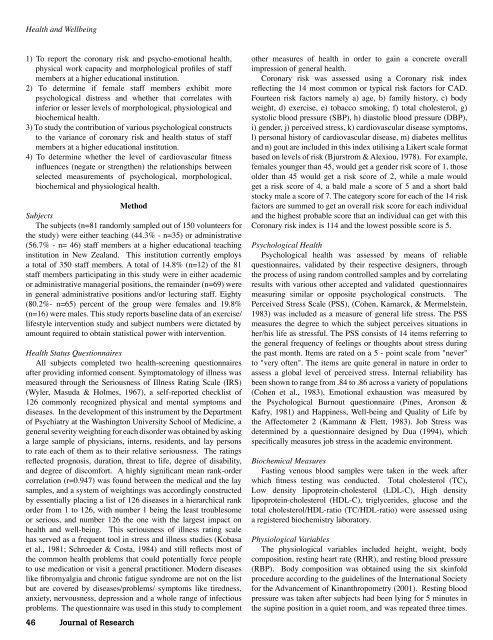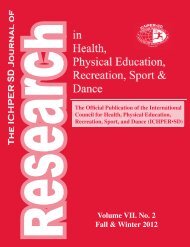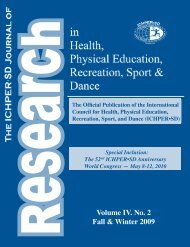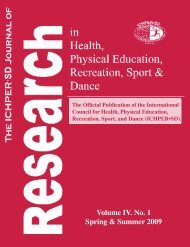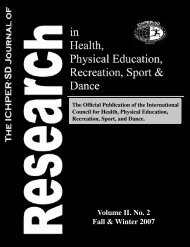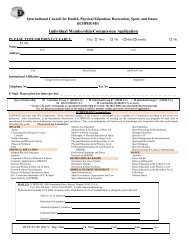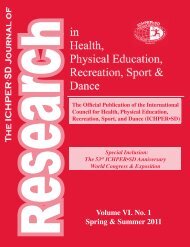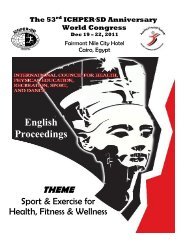Volume V. No. 1 Spring & Summer 2010 - ichperâ¢sd
Volume V. No. 1 Spring & Summer 2010 - ichperâ¢sd
Volume V. No. 1 Spring & Summer 2010 - ichperâ¢sd
You also want an ePaper? Increase the reach of your titles
YUMPU automatically turns print PDFs into web optimized ePapers that Google loves.
Health and Wellbeing<br />
1) To report the coronary risk and psycho-emotional health,<br />
physical work capacity and morphological profiles of staff<br />
members at a higher educational institution.<br />
2) To determine if female staff members exhibit more<br />
psychological distress and whether that correlates with<br />
inferior or lesser levels of morphological, physiological and<br />
biochemical health.<br />
3) To study the contribution of various psychological constructs<br />
to the variance of coronary risk and health status of staff<br />
members at a higher educational institution.<br />
4) To determine whether the level of cardiovascular fitness<br />
influences (negate or strengthen) the relationships between<br />
selected measurements of psychological, morphological,<br />
biochemical and physiological health.<br />
Method<br />
Subjects<br />
The subjects (n=81 randomly sampled out of 150 volunteers for<br />
the study) were either teaching (44.3% - n=35) or administrative<br />
(56.7% - n= 46) staff members at a higher educational teaching<br />
institution in New Zealand. This institution currently employs<br />
a total of 350 staff members. A total of 14.8% (n=12) of the 81<br />
staff members participating in this study were in either academic<br />
or administrative managerial positions, the remainder (n=69) were<br />
in general administrative positions and/or lecturing staff. Eighty<br />
(80.2%- n=65) percent of the group were females and 19.8%<br />
(n=16) were males. This study reports baseline data of an exercise/<br />
lifestyle intervention study and subject numbers were dictated by<br />
amount required to obtain statistical power with intervention.<br />
Health Status Questionnaires<br />
All subjects completed two health-screening questionnaires<br />
after providing informed consent. Symptomatology of illness was<br />
measured through the Seriousness of Illness Rating Scale (IRS)<br />
(Wyler, Masuda & Holmes, 1967), a self-reported checklist of<br />
126 commonly recognized physical and mental symptoms and<br />
diseases. In the development of this instrument by the Department<br />
of Psychiatry at the Washington University School of Medicine, a<br />
general severity weighting for each disorder was obtained by asking<br />
a large sample of physicians, interns, residents, and lay persons<br />
to rate each of them as to their relative seriousness. The ratings<br />
reflected prognosis, duration, threat to life, degree of disability,<br />
and degree of discomfort. A highly significant mean rank-order<br />
correlation (r=0.947) was found between the medical and the lay<br />
samples, and a system of weightings was accordingly constructed<br />
by essentially placing a list of 126 diseases in a hierarchical rank<br />
order from 1 to 126, with number 1 being the least troublesome<br />
or serious, and number 126 the one with the largest impact on<br />
health and well-being. This seriousness of illness rating scale<br />
has served as a frequent tool in stress and illness studies (Kobasa<br />
et al., 1981; Schroeder & Costa, 1984) and still reflects most of<br />
the common health problems that could potentially force people<br />
to use medication or visit a general practitioner. Modern diseases<br />
like fibromyalgia and chronic fatigue syndrome are not on the list<br />
but are covered by diseases/problems/ symptoms like tiredness,<br />
anxiety, nervousness, depression and a whole range of infectious<br />
problems. The questionnaire was used in this study to complement<br />
46 Journal of Research<br />
other measures of health in order to gain a concrete overall<br />
impression of general health.<br />
Coronary risk was assessed using a Coronary risk index<br />
reflecting the 14 most common or typical risk factors for CAD.<br />
Fourteen risk factors namely a) age, b) family history, c) body<br />
weight, d) exercise, e) tobacco smoking, f) total cholesterol, g)<br />
systolic blood pressure (SBP), h) diastolic blood pressure (DBP),<br />
i) gender, j) perceived stress, k) cardiovascular disease symptoms,<br />
l) personal history of cardiovascular disease, m) diabetes mellitus<br />
and n) gout are included in this index utilising a Likert scale format<br />
based on levels of risk (Bjurstrom & Alexiou, 1978). For example,<br />
females younger than 45, would get a gender risk score of 1, those<br />
older than 45 would get a risk score of 2, while a male would<br />
get a risk score of 4, a bald male a score of 5 and a short bald<br />
stocky male a score of 7. The category score for each of the 14 risk<br />
factors are summed to get an overall risk score for each individual<br />
and the highest probable score that an individual can get with this<br />
Coronary risk index is 114 and the lowest possible score is 5.<br />
Psychological Health<br />
Psychological health was assessed by means of reliable<br />
questionnaires, validated by their respective designers, through<br />
the process of using random controlled samples and by correlating<br />
results with various other accepted and validated questionnaires<br />
measuring similar or opposite psychological constructs. The<br />
Perceived Stress Scale (PSS), (Cohen, Kamarck, & Mermelstein,<br />
1983) was included as a measure of general life stress. The PSS<br />
measures the degree to which the subject perceives situations in<br />
her/his life as stressful. The PSS consists of 14 items referring to<br />
the general frequency of feelings or thoughts about stress during<br />
the past month. Items are rated on a 5 - point scale from "never"<br />
to "very often". The items are quite general in nature in order to<br />
assess a global level of perceived stress. Internal reliability has<br />
been shown to range from .84 to .86 across a variety of populations<br />
(Cohen et al., 1983). Emotional exhaustion was measured by<br />
the Psychological Burnout questionnaire (Pines, Aronson &<br />
Kafry, 1981) and Happiness, Well-being and Quality of Life by<br />
the Affectometer 2 (Kammann & Flett, 1983). Job Stress was<br />
determined by a questionnaire designed by Dua (1994), which<br />
specifically measures job stress in the academic environment.<br />
Biochemical Measures<br />
Fasting venous blood samples were taken in the week after<br />
which fitness testing was conducted. Total cholesterol (TC),<br />
Low density lipoprotein-cholesterol (LDL-C), High density<br />
lipoprotein-cholesterol (HDL-C), triglycerides, glucose and the<br />
total cholesterol/HDL-ratio (TC/HDL-ratio) were assessed using<br />
a registered biochemistry laboratory.<br />
Physiological Variables<br />
The physiological variables included height, weight, body<br />
composition, resting heart rate (RHR), and resting blood pressure<br />
(RBP). Body composition was obtained using the six skinfold<br />
procedure according to the guidelines of the International Society<br />
for the Advancement of Kinanthropometry (2001). Resting blood<br />
pressure was taken after subjects had been lying for 5 minutes in<br />
the supine position in a quiet room, and was repeated three times.


